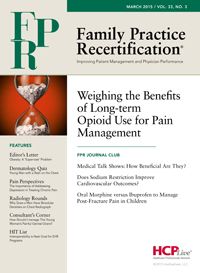Publication
Article
Family Practice Recertification
The Importance of Addressing Depression in Treating Chronic Pain
Author(s):
For patients dealing with chronic pain, the issues of their overall care can go beyond the body and into their minds. Addressing both areas can be key to helping them have normal everyday lives.

As discussed in an earlier installment of Pain Perspectives, chronic pain is a biopsychosocial phenomenon — addressing every aspect of the sufferer’s being. I believe that the duration of pain is not sufficient to determine chronicity; rather, chronic pain affects patients in a myriad ways — including vocationally, financially, legally, socially, recreationally, sexually, spiritually, and, of course, emotionally. This month’s Pain Perspectives will begin to address the emotional components of chronic pain, and the futility of trying to treat these patients in a primary care practice without addressing their psychological sequelae.
Numerous investigators have examined the prevalence of depression in patients with chronic pain. Unfortunately, the literature underestimates this prevalence, as most studies use the criteria for a Major Depressive Disorder in assessing depression. This can result in missing less severe types of depressive disorders. For example, a study of over 100,000 chronic low back pain patients identified depression in only 13% of its sample (1).
However, a Croatian study found at least some degree of depression in 74% of low back pain patients studied (2). The lesson here, is that patients don’t necessarily need to meet the criteria for a Major Depressive Disorder when considering that all depression hurts! It is also important to consider that, the relationship between pain and depression is reciprocal — with pain potentially causing depression, and depression potentially causing pain.
Research has indicated that pain and depression share common neuro-chemical pathways (3), which may explain their reciprocal relationship. Irrespective, data indicate that when the depressive component of chronic pain is not treated, outcomes are less likely to be positive (4,5).
There are a number of steps that the primary care provider can take to assess depression in patients with chronic pain — as well as patients in general. First and foremost is the face-to-face encounter. Does the patient appear dysphoric? Does he or she complain of sleep and/or appetite disturbances? Does your patient complain of fatigue or problems with concentration?
While there are many symptoms of depression, these are some of the more obvious and common signs (6). In many cases, assessing the obvious symptoms is probably insufficient. Given the comorbidity of pain and depression, it is also appropriate to simply ask a patient with chronic pain whether he or she is depressed.
Diagnosis of these patients can be complicated as, many with depression and pain don’t demonstrate common signs, and may not possess the insight to recognize that they are depressed. Accordingly, all patients with chronic pain should be administered one of the brief, highly reliable and valid symptom-based depression screens that are available at no cost — such as the Zung Self-Rating Depression Scale (available at https://psychology-tools.com/zung-depression-scale/). This measure can be computer administered and automatically scored, typically within 5 minutes.
Next month, we will begin to look at strategies for treating the depression that is typically an aspect of chronic pain syndromes. Remember, we haven’t done our jobs when we’ve treated only the pain. Primary care pain management is designed such that it allows the clinician to treat the person with pain. Such an approach will not only help your patients, but is also one that you will likely find more fulfilling.
References
1) Gore M, Sadosky A, Stacey BR, Tai KS, Leslie D. The burden of chronic low back pain: clinical comorbidities, treatment patterns, and health care costs in usual care settings. Spine 2012;37:E668-E677.
2) MarÄić M, Mihalj M, Ivica N, Pintarić I, Titlić M. How severe is depression in low back pain patients? Acta Clin Croat. 2014;53:267-271.
3) Jann MW, Slade JH. Antidepressant agents for the treatment of chronic pain and depression. Pharmacotherapy 2007;27:1571-1587.
4) Bair MJ, Robinson RL, Katon W, Kroenke K: Depression and pain comorbidity: a literature review. Arch Intern Med. 2003;163:2433—2445.
5) Kroenke K, Wu J, Bair MJ, Krebs EE, Damush TM, Tu W. Reciprocal relationship between pain and depression: a 12-month longitudinal analysis in primary care. J Pain 2011;12:964-973.
6) Kirkanski K, Joormann J, Gotlib IH. Cognitive aspects of depression. Wiley Interdiscip Rev Cogn Sci. 2012;3:301-313.






